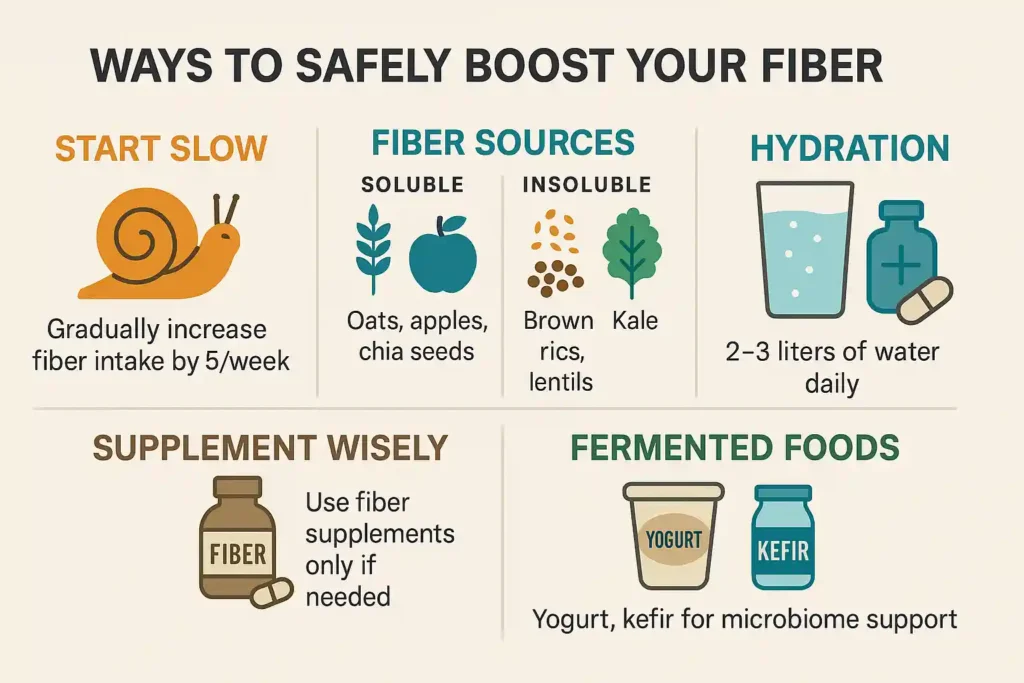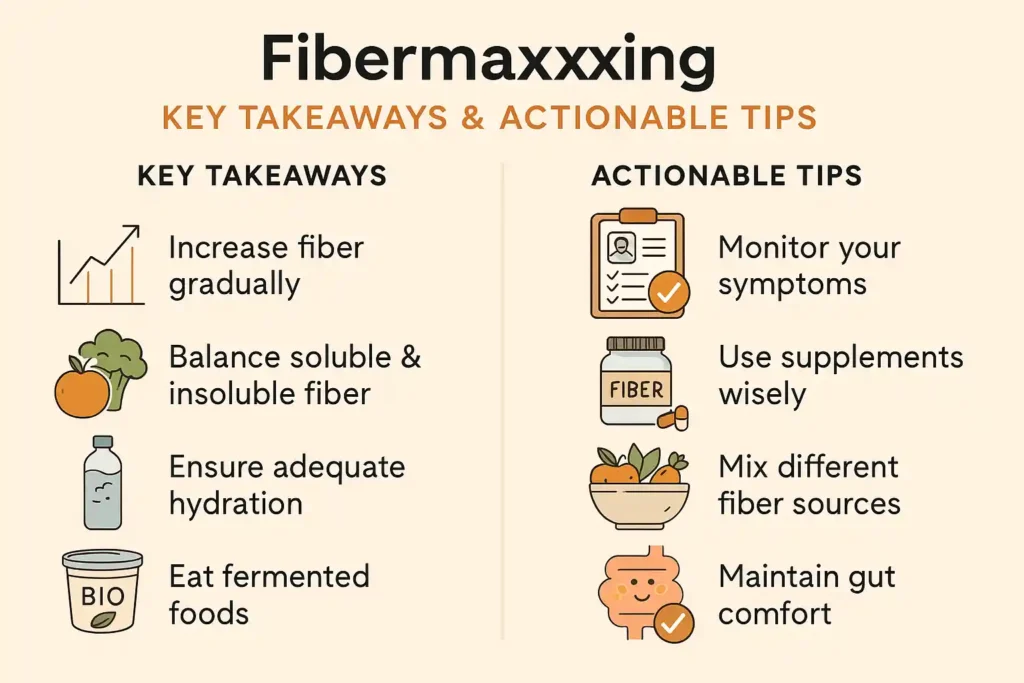Key Takeaways
- Fibermaxxing is a smarter way to increase your dietary fiber without getting bloated.
- A high fiber diet can improve gut health, control appetite, support weight management, and even help in chronic disease prevention.
- Jumping into fiber too fast can backfire, leading to bloating, gas, or cramping and gas.
- Not all fiber is the same: you need both soluble fiber and insoluble fiber in balance.
- Fiber supplements help, but fiber-rich foods are better for long-term results.
What Is Fibermaxxing?
Fibermaxxing is the method of gradually increasing your dietary fiber through fiber-rich foods and, when needed, fiber supplements, while keeping your digestive comfort intact. It’s not about stuffing salads down your throat or doubling your bean intake overnight. It’s about understanding how fiber and digestive health work together and how to improve them without triggering gas, bloating, or discomfort.
Table of Contents
ToggleIt centers around choosing the right types of fiber, like soluble fiber from oats, apples, and beans that gel with water and slow digestion, and insoluble fiber from veggies and whole grains that help keep things moving. Balancing these supports a healthy microbiome and offers real digestion support.
Most people fall short on their fiber intake, which weakens gut health over time. Fibermaxxing helps fill this gap while avoiding the side effects that often make people give up too soon.
The Science-Backed Benefits of a High-Fiber Diet

A high fiber diet does more than make you feel full. It works deep inside your digestive system, fixing issues from irregular bowel movements to poor nutrient absorption. Here’s what science says:
- Supports gut health: Both types of fiber fuel your good gut bacteria, creating a more balanced and diverse microbiome. That leads to better fiber and digestive health.
- Improves blood sugar balance: Soluble fiber slows down sugar absorption, which helps regulate insulin response.
- Boosts weight management: Fiber fills your stomach and keeps you fuller longer, aiding appetite control without extra calories.
- Reduces disease risk: A high fiber diet is linked to lower risk of heart disease, Type 2 diabetes, and colorectal cancer, proving its power in chronic disease prevention.
- Enhances metabolism: Improved digestion and regularity lead to more efficient metabolism and detox.
Adding fiber gradually helps prevent cramping and gas while providing these long-term health benefits.
Is There Such a Thing as Too Much Fiber?
Absolutely. Going from 10g a day to 40g overnight is like sprinting before you learn to walk.
If your body has not adapted to fiber, consuming too much too quickly can cause:
- Bloating
- Gas
- Cramping and gas
- Constipation (yes, really)
- Fiber sensitivity
This is where most people go wrong. They hear fiber is great and overdo it. Then they feel worse and quit.
This is why Fibermaxxing focuses on slow increase and proper hydration. It prevents the sudden overload that leads to bloating and fiber problems or fiber sensitivity. Start small, give your gut a chance to catch up, and increase over weeks, not days.
How Much Fiber Do You Really Need?
It is important to know your recommended daily fiber intake for successful outcomes. Here’s a breakdown:
- Men under 50: 38g
- Women under 50: 25g
- Men over 50: 30g
- Women over 50: 21g
Despite these clear numbers, most people only consume about 15g/day—way too low for ideal fiber and digestive health.
Focus on gradual increase using a mix of soluble fiber and insoluble fiber from foods like:
- Oats, apples, chia seeds (soluble fiber)
- Brown rice, kale, lentils (insoluble fiber)
This mix fuels your gut health, balances your digestive system, and improves how your body processes nutrients.
How to Safely Try Fibermaxxing

The process of maximizing fiber should be done slowly and steadily, rather than in haste.
Here’s how to do it right:
- Add fiber gradually: Increase by 5g per week. Let your body adjust before adding more.
- Focus on whole food sources: Choose fiber-rich foods like lentils, berries, flaxseeds, and quinoa. These provide both types of fiber.
- Hydrate constantly: Aim for 2–3 liters of water per day. This keeps bloating and constipation away.
- Balance your plate: Build high-fiber meals that mix carbs, proteins, and fats to improve nutrient absorption and comfort.
- Use fiber supplements wisely: If you’re low on fiber, fiber supplements can help, but don’t rely on them for long-term success.
- Watch your symptoms: Mild gas is okay at first. But if you feel sharp cramping and gas, pause or reduce fiber.
- Include fermented foods: A spoon of yogurt or kefir daily helps your body build a stronger healthy microbiome to handle more fiber.
This slow, targeted method offers real digestion support and lasting comfort.
Who Should Be Cautious About Fibermaxxing?
Not everyone can increase fiber quickly. People with gut disorders like IBS / IBD may need a personalized plan.
Here are groups who should talk to a doctor first:
- Those with IBS / IBD or a sensitive gut
- People who recently had bowel surgery
- Anyone experiencing chronic bloating or fiber sensitivity
- People on low-residue diets or medications affecting digestion
If you’re in any of these groups, don’t avoid fiber altogether. Just work with a dietitian to safely adjust your fiber intake over time.
The Bottom Line
Fibermaxxing is more than a wellness trend, it’s a practical way to boost your health with long-lasting benefits. It promotes better fiber and digestive health, supports a high fiber diet, and can ease digestive symptoms when done right.
With the right mix of soluble fiber, insoluble fiber, and fiber supplements, you can protect your gut health while avoiding common issues like bloating. The focus should be on gradual changes, ensuring adequate hydration, and paying attention to your body’s responses.
You don’t need a complicated plan. You just need smarter habits.
With smart planning and a gentle increase, you can enjoy all the power of a high fiber diet, without the dreaded bloating.
FAQs
What is fibermaxxing?
Fibermaxxing is a method of slowly increasing fiber intake through whole foods and fiber supplements to improve gut health and digestion without causing bloating.
Is fibermaxxing safe for everyone?
It’s safe for most, but people with IBS / IBD or gut conditions should go slow and get medical advice before increasing dietary fiber.
How much fiber should I eat daily?
The recommended daily intake is 25–38g. Start low and increase slowly to avoid bloating and fiber side effects or fiber sensitivity.
Can too much fiber cause bloating and gas?
Yes. Rapid fiber intake increases can lead to bloating, gas, cramping, and discomfort if your body isn’t ready for it.
What foods are best for fibermaxxing?
Focus on fiber-rich foods like oats, lentils, berries, chia seeds, and broccoli to get both soluble and insoluble fiber.
What’s the difference between soluble and insoluble fiber?
Soluble fiber absorbs water and slows digestion; insoluble fiber adds bulk and speeds waste removal through the colon.
Do fiber supplements work the same as whole foods?
Fiber supplements can help fill gaps but don’t offer the same benefits as real foods for nutrient absorption and gut bacteria.
Can fibermaxxing help with weight loss?
Yes. Fiber increases fullness, boosts appetite control, and supports weight management when combined with a healthy lifestyle.

This article is medically reviewed by Dr. Nivedita Pandey, Senior Gastroenterologist and Hepatologist, ensuring accurate and reliable health information.
Dr. Nivedita Pandey is a U.S.-trained gastroenterologist specializing in pre and post-liver transplant care, as well as managing chronic gastrointestinal disorders. Known for her compassionate and patient-centered approach, Dr. Pandey is dedicated to delivering the highest quality of care to each patient.








